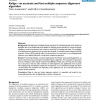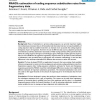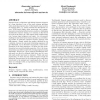1607 search results - page 43 / 322 » The existence of k-radius sequences |
BMCBI
2007
13 years 10 months ago
2007
Background: In many contexts, researchers need specific primers for all sequences in a family such that each primer set amplifies only its target sequence and none of the others, ...
BMCBI
2005
13 years 10 months ago
2005
Background: The alignment of multiple protein sequences is a fundamental step in the analysis of biological data. It has traditionally been applied to analyzing protein families f...
BMCBI
2004
13 years 10 months ago
2004
Background: The prediction of ancestral protein sequences from multiple sequence alignments is useful for many bioinformatics analyses. Predicting ancestral sequences is not a sim...
BMCBI
2004
13 years 10 months ago
2004
Background: Rates of substitution in protein-coding sequences can provide important insights into evolutionary processes that are of biomedical and theoretical interest. Increased...
PVLDB
2008
13 years 9 months ago
2008
Sequence data is ubiquitous and finding frequent sequences in a large database is one of the most common problems when analyzing sequence data. Unfortunately many sources of seque...



